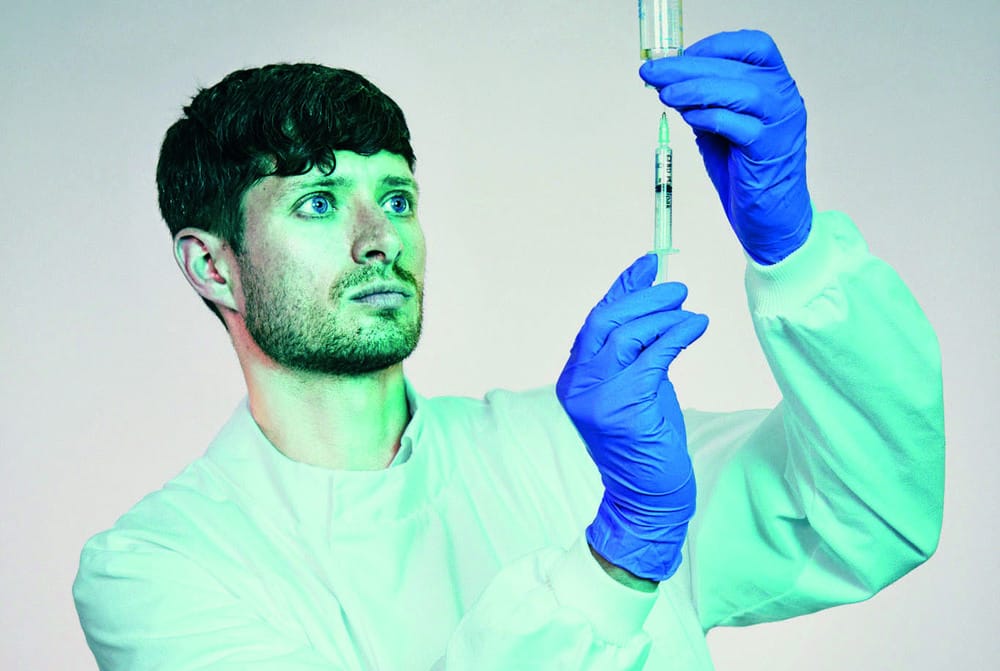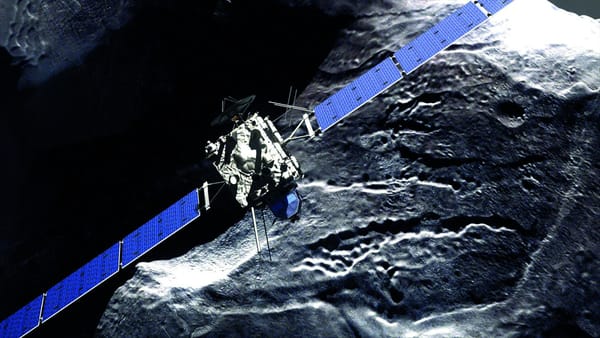Dr Robin Carhart-Harris talks about LSD and the Psychedelic state Psychedelic State
Lauren Ratcliffe interviews Imperial researcher and learns how and why LSD could be used to treat depression and addictions

Complete understanding behind the powerful effects of psychedelics on the mind has remained a mystery for many decades. Over 60 years has passed since the first discovery of lysergic acid diethylamide (LSD) and since then surprisingly little concrete knowledge of its effects on the brain has been established.
Legal restrictions and long-held preconceptions surrounding psychedelics have hampered the progression of research into these elusive compounds. Dr Robin Carhart-Harris of Imperial College University is one of a few scientists on the pursuit to bring a more scientific approach to modern psychedelic research and has found evidence to indicate that psychedelics are more than just a faded hippie emblem.
I met up with him in his offices in Hammersmith and discussed, among other things, the rise and fall of LSD in the scientific and public domain, theories behind hallucinations, near-death experiences and his research in using LSD to understand the inner workings of the mind.
LSD DISCOVERY
To fully understand where science is today we must take a brief look it’s past. The discovery of LSD’s unique effects arose accidently by Albert Hofmann during the 1930s.
Then a 37 year old medicinal chemist at the pharmaceutical company Sandoz in Basel, Hofmann began isolating active components of medicinal plants, one of which was ergot - a parasitic fungus that grows in rye and used back then to reduce maternal bleeding during childbirth.
During this pursuit in April 1943, he inadvertently exposed himself to LSD, an ergotamine derivative, and came home one day to find himself tripping balls, or as he puts it: “I perceived an uninterrupted stream of fantastic pictures, extraordinary shapes with intense kaleidoscopic play of colours.”
CONTROVERSY
Soon after this quirky discovery, further scientific research established that LSD could lower ego defences and potentially allow access to the unconscious mind, revealing it as a potential tool to use in conjunction with psychotherapy treatments.
Between the 1950s and mid-1960s over 1,000 clinical papers and several dozen books were published alongside six international conferences on LSD-assisted psychotherapy. However, what Hofmann could never have foretold was the progression of LSD from medical remedy to recreational drug.
When, after more than ten years of uninterrupted scientific research, the drug began to take on a more public profile as sensationalist newspaper reports on LSD’s curious effects opened the doors to public experimentation.
One figure that spearheaded this transition was Dr Timothy Leary, a known apostle of LSD, who held a vision that progressively diverted from scientific research and moved towards the dangerous game of social and psychological revolution.
People began taking LSD for pleasure and popularity of the drug grew almost synonymously with the hippie movement, taken as a way to get in touch with the self, other people and the environment, or to quote Leary: “Turn on, tune in, drop out.”
In 1966, due to bad publicity and political concerns, the authorities took direct action against LSD and made it illegal in the United States. What shortly followed was the implementation of the UK Misuse of Drugs Act in 1973, classing LSD under Schedule I, which by definition assumes it has little or no therapeutic value.
SUGGESTIBILITY
Since then, the story has stayed much the same and drug policies more or less haven’t changed since the 1970s. In the Centre for Neuropsychopharmacology at Imperial College, however, Dr Robin Carhart-Harris is pioneering investigations into LSD with results that suggest a change is long overdue as current drug laws suffocate the progression of neuroscience research. By piling up strong evidence-based scientific knowledge on LSD’s effects on the brain, Carhart-Harris is bringing a refreshingly scientific approach to this weird and wonderful drug.
With a background in psychology and psychoanalysis at Bournemouth University, Carhart-Harris later moved to the University of Bristol to continue a PhD in psychopharmacology and is now a research associate at Imperial College’s Hammersmith campus, where I found him one fresh October morning. With an infectious enthusiasm for his work and a clear, careful way of speaking, Carhart-Harris describes his progression from psychology to psychedelic research when, during his undergraduate years, his studies failed to satisfy his deep curiosity in wanting to understand the human condition. “[Psychoanalysis] doesn’t have much grounding in a scientific approach… it was more going around the edges and not getting to the core of what is really interesting and juicy,” he explains.
What truly changed the game, however, was his discovery of the book ‘Realms of the Human Unconsciousness: Observations from LSD Research’ by Czech psychiatrist, Stanislav Grof, who worked on LSD in the 60s and 70s. “I read it in a day, was blown away and then thought this is really what I want to do, understand LSD in the mind and put some real meat on psychoanalysis,” he says.
Carhart-Harris’ research uses LSD as a way to manipulate the mind and understand what processes are underlying common psychopathologies. “It is under appreciated by mainstream psychology and cognitive neuroscience quite how important and useful psychedelic drugs can be for explaining the mind,” Carhart-Harris says.
“Psychedelics are powerful scientific tools, in order to understand any phenomenon, a powerful strategy is to perturb the phenomenon, which LSD does.”
A recently published study of his investigates the effect of LSD on imaginative suggestibility; he would read out a script asking volunteers to imagine, with eyes closed, a succession of sensory experiences, like eating a juicy orange or smelling freshly cut grass. “[Volunteers] fall into a fantasy state where they are imagining what I am suggesting,” he says.
When they asked participants to rate the vividness of the experience, the extreme being it was just like reality, the participants of the study that had the LSD treatment rated it as significantly more vivid compared to control. Without needing hypnosis or any authoritarian commands, LSD induced a state of plasticity in the volunteers’ perception of the world, indicating big potential for use in psychotherapy.
However, it remains a territory that some people from a strict medical perspective might question. “There is this psychological element that some people might find too qualitative and abstract. But you just have to look at the placebo effect to see how effective it can be,” Carhart-Harris explains.
ADDICTIONS
Alongside apparent heightened suggestibility, Carhart-Harris’ research indicates that LSD could help with the treatment of addictions and depression. “Ordinarily when we experience the world, we do so in such a constrained manner...habits and routines we have are all about digging certain channels in a way that we slip into,” he says. “Psychedelics start to fill in those channels that have already been dug out so that they are shallower and you can start falling into different channels.”
This happens not just on a metaphorical level but also mirrors what Carhart-Harris has found in changes of brain activity. “Brain activity is governed to a large extent by important hub structures that are important for governing the channels of activity that the brain supports, and to some extent constraining the circuitry of the brain. What we see with LSD and other psychedelics is that these hub structures are affected and their activity is disturbed, which seems to allow the brain to work in an unconstrained manner. Cognition can be more flexible and to some extent broader as connections can be formed between regions that are ordinarily not connected or weakly connected, so we see this heightened plasticity and intercommunication within the brain that we would not see ordinarily,” he explains.
Using psychedelics to disrupt reinforced patterns on the brain in people with addictions or depression could introduce a suppleness of the mind, where new things can be learnt whilst old things are unlearnt. A recent study in the United States into psilocybin (magic mushrooms) and tobacco addiction, found that 80% of smokers treated with psilocybin, with the intention of giving up cigarettes, abstain from smoking 6 months after the treatment, a better result than the current best treatment for tobacco addiction.
“I have a strong conviction that [psychedelics] will develop into therapeutics in the coming decades,” Carhart-Harris says.
HALLUCINATIONS
Out of interest, I thought I’d pick the doctor’s brain on his theory behind the manifestation of hallucinations while under the influence of psychedelic drugs. These phantom visions have historically played a huge role in mysticism, the history of religion and the religious experience.
“I don’t have a really good explanation for hallucinations, but we have some clues,” he says. “One explanation I could offer is that the brain holds priors or predictions about what it is going to be given in terms of sensory information. We come into this world with some innate information about what the world will be like, but you also develop an incredible amount of knowledge about how the world is and this develops over time so that we can process the world much more accurately and precisely.
What you see with psychedelics is that these priors and predictions start slipping into conscious when not induced,” he clarifies. “Essentially what you are seeing under LSD is the brain itself, the information that the brain already holds is slipping into our normal consciousness.”
DMT
“There are always drugs we would like to look at, but are unable to because of limited resources and prioritising research” Carhart-Harris says when asked if there were any other psychedelics he would like to investigate apart from LSD and psilocybin.
“An interesting one is N,N-dimethyltryptamine (DMT), which occurs endogenously within the human body and in other organisms, and is prevalent in the plant world. It is amazingly similar in molecular structure to other chemicals present within the body that do important things in terms of psychology, like serotonin for example,” he says.
There are many wild and wonderful theories surrounding DMT and people have theorised that it may be responsible for certain endogenous psychedelic, mystical-type experiences and how these arise in certain circumstances such as near-death. “I’m not sure I agree, it’s good to keep an open mind… but there is another theory that is more intuitively appealing – that states of naturally occurring psychosis, when people go ‘mad’ so to speak, is due to endogenous psychedelic-like compounds being released in the brain, DMT is the main candidate for that – but there is no evidence.”
In order to get some conclusive backing for this theory, researchers would need to carry out a spinal tap and analyse the cerebrospinal fluid (CSF) to give a good index of what’s in the brain in someone in a state of acute psychosis. “Some of the best studies that would really crack a problem, are simply not feasible,” Carhart-Harris says.
Psychedelic research is still very young, but seems to be an incredibly fertile domain and on the up. Of course, these compounds are to be treated with caution and Carhart-Harris’ research is carried out under carefully controlled settings. “The dangers with psychedelics arise when they are taken without the proper caution,” he says.
For many drugs the decisions to classify them under Schedule I in the current UK drug legislation was made before modern scientific methods allowed a more comprehensive understanding of their pharmacology and toxicology. As a result, drugs were lumped into groups not based on any consideration of their physical harms but on the assumption they had no therapeutic value.
By breaking the 50 year taboo surrounding psychedelics in research and confronting the mysterious with honest scientific methods, Dr Robin Carhart-Harris and his team of researchers have found evidence that contradicts this assumption.








